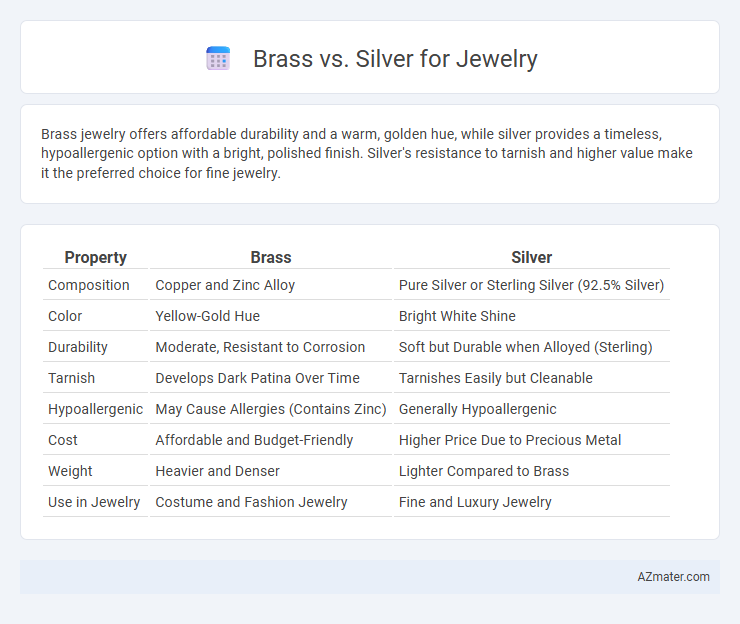Brass jewelry offers affordable durability and a warm, golden hue, while silver provides a timeless, hypoallergenic option with a bright, polished finish. Silver's resistance to tarnish and higher value make it the preferred choice for fine jewelry.
Table of Comparison
| Property | Brass | Silver |
|---|---|---|
| Composition | Copper and Zinc Alloy | Pure Silver or Sterling Silver (92.5% Silver) |
| Color | Yellow-Gold Hue | Bright White Shine |
| Durability | Moderate, Resistant to Corrosion | Soft but Durable when Alloyed (Sterling) |
| Tarnish | Develops Dark Patina Over Time | Tarnishes Easily but Cleanable |
| Hypoallergenic | May Cause Allergies (Contains Zinc) | Generally Hypoallergenic |
| Cost | Affordable and Budget-Friendly | Higher Price Due to Precious Metal |
| Weight | Heavier and Denser | Lighter Compared to Brass |
| Use in Jewelry | Costume and Fashion Jewelry | Fine and Luxury Jewelry |
Introduction to Brass and Silver in Jewelry
Brass, an alloy of copper and zinc, is valued in jewelry for its warm gold-like appearance and affordability, making it a popular choice for fashion and statement pieces. Silver, primarily composed of pure silver with small amounts of other metals for durability, is prized for its bright luster, hypoallergenic properties, and timeless elegance in fine jewelry. Both metals offer distinct aesthetic and practical benefits, influencing their selection based on style preferences and budget considerations.
Physical Properties: Brass vs Silver
Brass is an alloy composed primarily of copper and zinc, known for its durability and resistance to tarnish, making it suitable for everyday jewelry wear. Silver, especially sterling silver with 92.5% purity, offers superior malleability and a bright, reflective luster but is softer and prone to tarnishing over time. The higher density of silver results in heavier jewelry compared to brass, which is lighter and more affordable without compromising strength.
Aesthetic Appeal: Color and Shine Comparison
Brass jewelry offers a warm, golden hue with a vintage-inspired shine that deepens over time due to natural patination, creating an antique aesthetic favored in bohemian and rustic designs. Silver jewelry provides a bright, reflective white luster that maintains its brilliance with proper care, delivering a sleek and modern appearance ideal for contemporary and minimalist styles. The choice between brass and silver for jewelry primarily depends on whether one prefers the rich, earthy tones and evolving shine of brass or the cool, radiant finish and timeless elegance of silver.
Durability and Wear: Longevity of Brass and Silver Jewelry
Brass jewelry is known for its durability and resistance to corrosion, making it suitable for everyday wear; however, it may tarnish over time and require regular cleaning to maintain its appearance. Silver jewelry, especially sterling silver, offers excellent longevity with proper care, though it is softer and more prone to scratches and dents compared to brass. Both metals can last for years, but silver's natural tarnishing can be a sign of authenticity and is easily polished, whereas brass often develops a patina that some wearers find desirable.
Tarnish and Maintenance Requirements
Brass jewelry tends to tarnish faster than silver due to its copper content, which reacts with air and moisture to form a dull patina requiring frequent cleaning. Silver, particularly sterling silver, also tarnishes but more slowly and can be restored with specialized polishes or ultrasonic cleaners. Proper maintenance for both metals involves regular cleaning and storing in airtight containers to minimize exposure to air and humidity, extending the lifespan and appearance of the jewelry.
Hypoallergenic Qualities and Skin Reactions
Silver jewelry, particularly sterling silver, is known for its hypoallergenic properties and is less likely to cause skin reactions compared to brass. Brass jewelry contains copper and zinc, which can trigger allergic responses or skin discoloration in sensitive individuals. Choosing high-quality sterling silver minimizes the risk of irritation, making it a preferred choice for hypoallergenic jewelry.
Price and Affordability
Brass jewelry offers a highly affordable alternative to silver, often costing a fraction of the price while maintaining a stylish appearance. Silver, especially sterling silver, commands a higher price due to its intrinsic value, durability, and hypoallergenic properties. Choosing brass can significantly reduce the cost of accessorizing without compromising on aesthetic appeal, making it ideal for budget-conscious buyers.
Popular Styles and Design Trends
Brass jewelry is favored for its warm, golden hue and affordability, making it popular in bohemian and vintage-inspired designs featuring intricate filigree and bold statement pieces. Silver remains a classic choice, prized for its sleek, polished look often used in minimalist, modern styles and delicate, detailed craftsmanship such as sterling silver rings and chains. Current design trends show a rise in mixed-metal jewelry, combining brass and silver elements to offer versatile accessories that blend rustic charm with contemporary elegance.
Environmental Impact and Sustainability
Brass jewelry, often made from copper and zinc, has a lower environmental footprint compared to silver due to less intensive mining processes and the potential for recycling scrap metals. Silver mining involves significant ecological disruption, water usage, and energy consumption, raising concerns about habitat destruction and pollution. Both metals can be sustainably sourced when recycled or obtained from certified eco-friendly mines, but brass typically offers a more environmentally conscious choice for jewelry manufacturers.
Choosing the Right Metal for Your Jewelry
Brass offers an affordable and durable option for jewelry, boasting a warm, gold-like appearance that resists tarnishing when properly sealed. Silver, particularly sterling silver, provides a classic, bright finish with hypoallergenic properties, making it ideal for sensitive skin despite requiring regular polishing to prevent oxidation. Choosing between brass and silver depends on factors such as budget, skin sensitivity, desired aesthetic, and maintenance commitment to ensure the perfect metal complements your jewelry collection.

Infographic: Brass vs Silver for Jewelry
 azmater.com
azmater.com